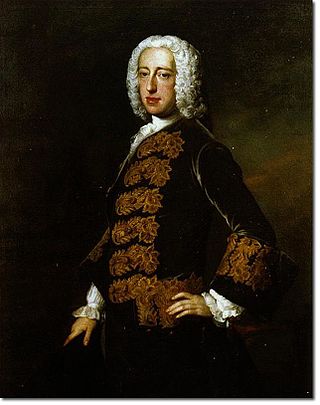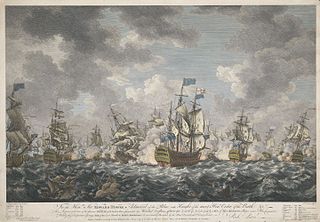
Admiral of the Fleet Richard Howe, 1st Earl Howe,, was a British naval officer. After serving throughout the War of the Austrian Succession, he gained a reputation for his role in amphibious operations against the French coast as part of Britain's policy of naval descents during the Seven Years' War. He also took part, as a naval captain, in the decisive British naval victory at the Battle of Quiberon Bay in November 1759.

This article details the history of the Scots Guards from 1642 to 1804. The Scots Guards (SG) is a regiment of the Guards Division of the British Army. The Scots Guards trace their origins back to 1642 when, by order of King Charles I, the regiment was raised by Archibald Campbell, 1st Marquess of Argyll for service in Ireland, and was known as the Marquis of Argyll's Royal Regiment. It spent a number of years there and performed a variety of duties, but in the mid-1640s, during the Wars of the Three Kingdoms, the regiment took part in the fight against James Graham, 1st Marquess of Montrose who was fighting on the side of Charles I. In 1646, Montrose left Scotland upon the defeat of the King in England.

Charles Spencer, 3rd Duke of Marlborough,, styled as The Honourable Charles Spencer between 1706 and 1729 and as the Earl of Sunderland between 1729 and 1733, was a British Army officer, politician and peer who served as Lord Privy Seal in 1755. He led the British forces involved in the raid on St Malo in 1758.

Cancale is a commune in the Ille-et-Vilaine department in Brittany in northwestern France. It is known as the birthplace of Saint Jeanne Jugan.

General Sir John Mordaunt was a British soldier and Whig politician, the son of Lieutenant-General Harry Mordaunt and Margaret Spencer. He was best known for his command of the Raid on Rochefort which ended in failure and his subsequent court-martial. Cleared on a technicality, he was nonetheless barred from holding further military command.

The 30th (Cambridgeshire) Regiment of Foot was an infantry regiment of the British Army, raised in 1702. Under the Childers Reforms it amalgamated with the 59th Regiment of Foot to form the East Lancashire Regiment in 1881.

The siege of Louisbourg was a pivotal operation of the French and Indian War in 1758 that ended French colonial dominance in Atlantic Canada and led to the subsequent British campaign to capture Quebec in 1759 and the remainder of New France the following year.

The British expedition against Guadeloupe was a military action from January to May 1759, as part of the Seven Years' War. A large British force had arrived in the West Indies, intending to seize French possessions. After a six-month-long battle to capture Guadeloupe they finally received the formal surrender of the island, just days before a large French relief force arrived under Admiral Maximin de Bompart.

The Battle of Saint-Cast was a military engagement during the Seven Years' War on the French coast between British naval and land expeditionary forces and French coastal defence forces. Fought on 11 September 1758, it was won by the French.

The Seven Years' War (1756–1763) was a global conflict involving most of the European great powers, fought primarily in Europe and the Americas. One of the opposing alliances was led by Great Britain and Prussia. The other alliance was led by France, backed by Spain, Saxony, Sweden, and Russia. Related conflicts include the 1754 to 1763 French and Indian War, and 1762 to 1763 Anglo-Spanish War.
Lieutenant General Thomas Bligh was an Irish-born British soldier, best known for his service during the Seven Years' War when he led a series of amphibious raids, known as "descents" on the French coastline. Despite initial success in these operations, they came to an end following the disastrous Battle of St Cast.

The Raid on Cherbourg took place in August 1758 during the Seven Years' War when a British force was landed on the coast of France by the Royal Navy with the intention of attacking the town of Cherbourg as part of the British government's policy of "descents" on the French coasts.

A French invasion of Great Britain was planned to take place in 1759 during the Seven Years' War, but due to various factors was never launched. The French planned to land 100,000 French soldiers in Britain to end British involvement in the war. The invasion was one of several failed French attempts during the 18th century to invade Britain.

Great Britain was one of the major participants in the Seven Years' War, which in fact lasted nine years, between 1754 and 1763. British involvement in the conflict began in 1754 in what became known as the French and Indian War. However the warfare in the European theatre involving countries other than Britain and France commenced in 1756. Britain emerged from the war as the world's leading colonial power, having gained all of New France in North America, ending France's role as a colonial power there. Following Spain's entry in the war in alliance with France in the third Family Compact, Britain captured the major Spanish ports of Havana, Cuba and Manila, in the Philippines in 1762, and agreed to return them in exchange for Spanish Florida. The Treaty of Paris in 1763 formally ended the conflict and Britain established itself as the world's pre-eminent naval power.

The Raid on Rochefort was a British amphibious attempt to capture the French Atlantic port of Rochefort in September 1757 during the Seven Years' War. The raid pioneered a new tactic of "descents" on the French coast, championed by William Pitt who had taken office a few months earlier.

The raid on Lorient was a British amphibious operation in the region around the town of Lorient from 29 September to 10 October 1746 during the War of the Austrian Succession. It was planned as an attempt to force the French to withdraw their forces from Flanders to reinforce their own coast. At the same time, as Lorient was used by the French East India Company as a base and supply depot, its destruction would serve British objectives in the East Indies.

The Capture of Belle Île was a British amphibious expedition to capture the French island of Belle Île off the Brittany coast in 1761, during the Seven Years' War. After an initial British attack was repulsed, a second attempt under General Studholme Hodgson forced a beachhead. A second landing was made, and after a six-week siege the island's main citadel at Le Palais was stormed, consolidating British control of the island. A French relief effort from the nearby mainland was unable to succeed because of British control of the sea. The British occupied the island for two years before returning it in 1763 following the Treaty of Paris.
Lieutenant-Colonel Robert Clerk was a British engineer officer who served in the War of the Austrian Succession and the Seven Years' War. His report on the state of the defences of Rochefort in 1757 was the main reason for that French naval port being chosen as the target for a major British expedition, the Raid on Rochefort, for which Clerk was appointed chief engineer.

The Battle of Saint-Malo was fought between Allied and German forces for control of the French coastal town of Saint-Malo in Brittany during World War II. The battle was part of the Allied breakout across France and took place between 4 August and 2 September 1944. United States Army units, with the support of Free French and British forces, successfully assaulted the town and defeated its German defenders. The German garrison on a nearby island continued to resist until 2 September.
Écluse was a gabarre launched at le Havre in 1764 for the French Navy. The navy lent her out to private parties who made one voyage as a slave ship (1770–1771), in the triangular trade in enslaved persons. She then returned to naval service. In May 1779 she participated in the unsuccessful invasion of Jersey; a British naval squadron succeeded in capturing or destroying much of the French squadron, and burnt Écluse. She was recovered and returned to service. In 1782, after the end of the war, the navy lent her out to serve as a merchantman. She was decommissioned in 1788.


















